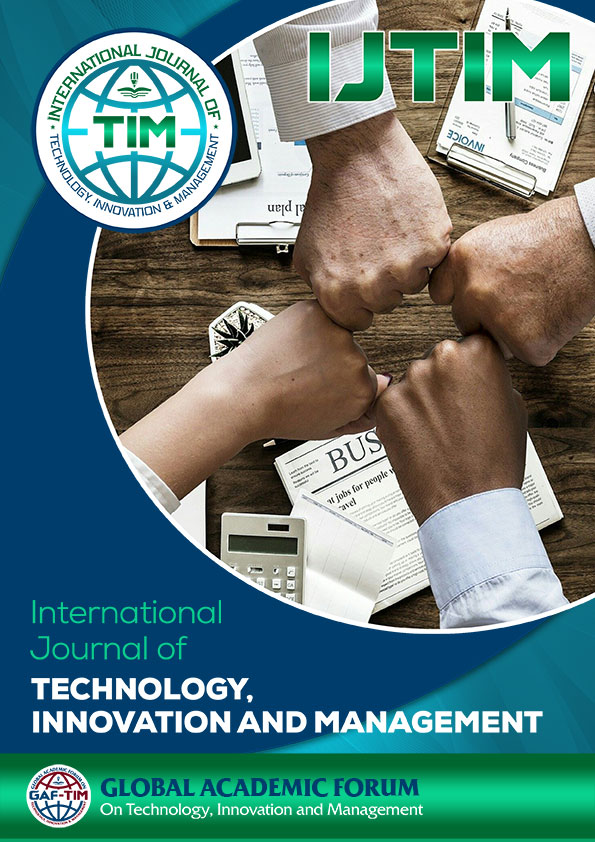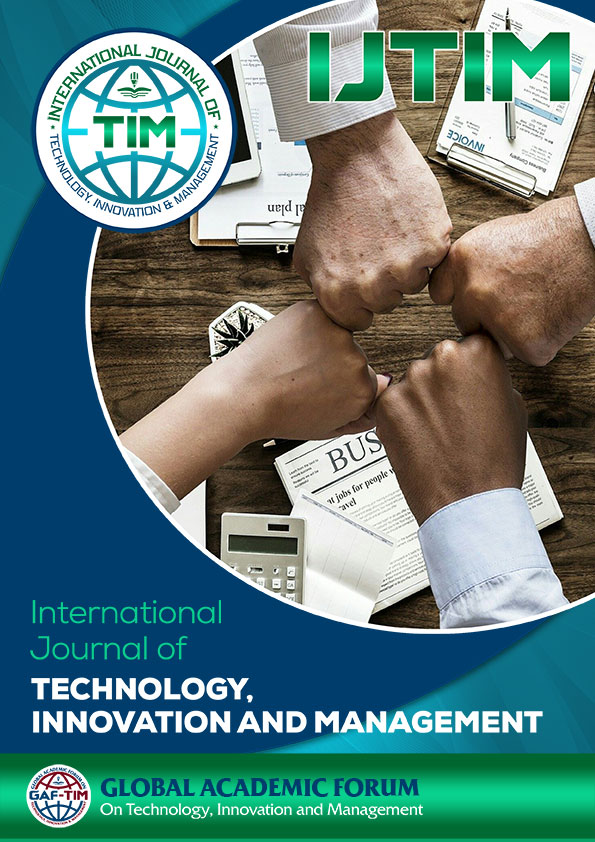Exploring the Online Leadership Effect on Blended Learning in Educational Institutions: Post-COVID-19 Learning Context
DOI:
https://doi.org/10.54489/1k1xsy97Keywords:
Online leadership, Idealized influence, Motivation, Intellectual stimulation, Educational schools, Blended learningAbstract
The COVID-19 pandemic has necessitated the transition of administrative and instructional work in schools to an online format. This shift has prompted school administrators to embrace online leadership as a suitable approach during and after the pandemic. Blended learning has been recommended as a sustainable and well- suited solution for educational institutions in the post-pandemic period.
Aims: to investigate the impact between online leadership and the adoption of blended learning in educational settings.
Sample(s): A total of 385 instructors participated in this study. The participants were surveyed using Google Forms to gather their perspectives.
Methods: Structural equation modelling (SEM) and path coefficients analysis were employed to analyse the survey data and examine the attitudes of instructors towards online leadership and blended learning.
Results: The findings indicated that online leadership (OL) exhibited a higher likelihood of being adopted for blended learning (BL) implementation, as revealed by the study results (59%). Instructors demonstrated increased flexibility and readiness to utilize online leadership methods for career advancement in the post- pandemic era. However, it should be noted that the adoption of online leadership measures was primarily driven by necessity (41%) to maintain continuity in educational practices during the pandemic.
Conclusions: These findings shed light on the significance of online leadership in facilitating the integration of blended learning in schools. The study highlights the adaptability of instructors and their recognition of the potential benefits associated with online leadership practices. The results emphasize the importance of online leadership as a strategic approach for educational institutions in navigating the challenges brought about by the COVID-19 pandemic and beyond.
References
Afshari, M., Bakar, K. A., Luan, W. S., & Siraj, S. (2012). Factors affecting the transformational leadership role of principals in implementing ICT in schools. Turkish Online Journal of Educational Technology-TOJET, 11(4), 164-176.
Agyemang, F. G., Boateng, H., & Dzandu, M. D. (2017). Examining intellectual stimulation, idealised influence and individualised consideration as an antecedent to knowledge sharing: Evidence from Ghana. Knowledge Management & E-Learning: An International Journal, 9(4), 484-498.
Ahmad, T. (2020). Corona Virus (COVID-19) Pandemic and Work from Home: Challenges of Cybercrimes and Cybersecurity. SSRN Electrical Journal, 1-4.
Al Bataineh KB, Banikalef AEAA, Albashtawi AH (2019) The effect of blended learning on EFL students' grammar performance and attitudes: an Investigatin of moodle. Arab World English J 10(1):324-334.
Alderbashi, K. (2021). Attitudes of primary school students in UAE towards using digital story-telling as a learning method in classroom. Research on Humanities and Social Sciences, 11(10), 20-28.
Al-Derbashi, K. Y., & Abed, O. H. (2017). The Level of Utilizing Blended Learning in Teaching Science from the Point of View of Science Teachers in Private Schools of Ajman Educational Zone. Journal of education and practice, 8(2), 193-205.
Ali, W. (2020). Online and remote learning in education institutes: A necessity in light of COVID-19 pandemic. Education Studies, 10(3), 16-25.
Alias, B. S., Zainuddin, Z. N., Ishak, M. R., & Mansor, A. N. (2021). Role of Principal in Promoting Teachers Unity: Evaluation in Malaysian Secondary Schools. Pertanika Journal of Social Sciences & Humanities, 29.
Alward, Erin, and Yvonne Phelps. "Impactful Idealized Influence of Virtual Leaders in Education." Online Learning 23.3 (2019): 72-93.
Apsorn, A., Sisan, B., & Pariyaporn, T. (2019). Information and Communication Technology Leadership of School Administrators in Thailand. International Journal of Instruction, 12(2), 639-650.
Arshad, M. M., Ismail, I. A., Fesol, S. F. A., & Ismail, A. (2021). Character Development and Youth Leadership Mentoring. Pertanika Journal of Social Sciences & Humanities, 29.
Aryee, S., Walumbwa, F. O., Zhou, Q., & Hartnell, C. A. (2012). Transformational leadership, innovative behavior, and task performance: Test of mediation and moderation processes. Human Performance, 25(1), 1-25.
Attieha, L., & Zouhairy, O. (2021). An Evaluation of How Educators in Virtual Teams Perceive Charismatic Leadership During the COVID-19 Crisis. International Journal of Organizational Leadership, 10, 155-170.
Avolio, B., & Kahai, S. (2003). Adding the "E" to E-Leadership: How it May Impact. Organizational Dynamics, 31(4), 325-338.
Bao, W. (2020). "COVID ‐19 and online teaching in education: A case study of Peking School", Human Behavior and Emerging Technologies, 2 (2), 113-115.
Barling, J., Weber, T., & Kelloway, E. K. (1996). Effects of transformational leadership training on attitudinal and financial outcomes: A field experiment. Journal of applied psychology, 81(6), 827.
Bass, B. M. (1997). Does the transactional–transformational leadership paradigm transcend organizational and national boundaries?. American psychologist, 52(2), 130.
Binkhorst, F., Poortman, C. L., McKenney, S. E., & Van Joolingen, W. R. (2018). Revealing the balancing act of vertical and shared leadership in Teacher Design Teams. Teaching and Teacher Education, 72, 1-12.
Birbal, R., Ramdas, M., & Harripaul, C. (2018). Student Teachers' attitudes towards Blended learning. Journal of Education and Human Development, 7(2), 9-26.
Blackburn, S., LaBerge, L., O’Toole, C., & Schneider, J. (2020). Digital strategy in a time of crisis. McKinsey Digital, April, 22.
Bolkan, S., Goodboy, A. K., & Griffin, D. J. (2011). Teacher leadership and intellectual stimulation: Improving students' approaches to studying through intrinsic motivation. Communication Research Reports, 28(4), 337-346.
Bonatti, A. & Horner, J. (2011). Collaborating. American Economic Review, 101. 632-663.
Bozeman, W., & Spuck, D. (1991). Technological Competence. Journal of Research on Computing in Education, 23(4), 514-529.
Bryant, N. (2013). Leadership development as a relational process: A grounded theory investigation of leader experiences (Doctoral dissertation, The Chicago School of Professional Psychology).
Busse, R., & Weidner, G. (2020). A qualitative investigation on combined effects of distant leadership, organisational agility and digital collaboration on perceived employee engagement. Leadership & Organization Development Journal, 41(4), 535-550.
Cassell, J., Huffaker, D., Tversky, D., & Ferriman, K. (2006). The language of online leadership: Gender and youth engagement on the Internet. Developmental psychology, 42(3), 436.
Chen, R. H. (2022). Effects of Deliberate Practice on Blended Learning Sustainability: A Community of Inquiry Perspective. Sustainability, 14(3), 1785.
Collins, K., & Ison, R. (2009). Jumping off Arnstein's ladder: social learning as a new policy paradigm for climate change adaptation. Environmental policy and governance, 19(6), 358-373.
Contreras, F., Baykal, E. and Abid, G., 2020. E-leadership and teleworking in times of COVID-19 and beyond: what we know and where do we go. Frontiers in Psychology, 11, p.3484.
Cortellazzo, L., Bruni, E., & Zampieri, R. (2019). The Role of Leadership in a Digitalized World: A Review. Front. Psychol., 10.
Crawford, J.; Percy, A. & Kelder, J. A. (2020). "JUTLP editorial 17.3: connection, digital education, and student-centric teaching practice before COVID-19", Journal of School Teaching & Learning Practice, 17 (3), 1.
Crisp, C. B., & Jarvenpaa, S. L. (2013). Swift trust in global virtual teams. Journal of personnel psychology.
Dale, V., Kubincova, E., Kerr, J., & Murray, J. A. (2021). Lessons learned from being BOLD: Staff experiences of an institutional strategic project in Blended and Online Learning Development. Journal of Perspectives in Applied Academic Practice, 9(2), 29-38.
Darling-Hammond, L., LaPointe, M., Meyerson, D., Orr, M. T., & Cohen, C. (2007). Preparing School Leaders for a Changing World: Lessons from Exemplary Leadership Development Programs. School Leadership Study. Final Report. Stanford Educational Leadership Institute.
Densten, I. L. (2002). Clarifying inspirational motivation and its relationship to extra effort. Leadership & Organization Development Journal.
Dirks, K. T., & Ferrin, D. L. (2002). Individualized Consideration: Meta- analytic findings and implications for research and practice. Journal of Applied Psychology, 87(4), 611-628.
Driscoll, M. (2002). Blended learning: Let’s get beyond the hype. E-learning, 1(4), 1-4.
Dziuban, C., Graham, C. R., Moskal, P. D., Norberg, A., & Sicilia, N. (2018). Blended learning: The new normal and emerging technologies. International Journal of Educational Technology in Education, 15(3), 1-16.
Eikenberry, K., & Turmel, W. (2018). The Long-Distance Leader: Rules for Remarkable Online leadership. Berrett-Koehler Publishers.
Fernandez, A. A., & Shaw, G. P. (2020). Academic leadership in a time of crisis: The Coronavirus and COVID‐19. Journal of leadership Studies, 14(1), 39-45.
Fornell, C., & Larcker, D. F. (1981). Structural equation models with unobservable variables and measurement error: Algebra and statistics.
Garrison, D. R., & Kanuka, H. (2004). Blended learning: Uncovering its transformative potential in education. The Internet and Education, 7(2), 95-105.
Garrison, D. R., & Vaughan, N. D. (2013). Institutional change and leadership associated with blended learning innovation: Two case studies. The Internet and Education, 18, 24-28.
Gerke, S. K. (2006). If I cannot see them, how can I lead them? Ind and Commercial Training, 38(2), 102-105.
Goh, S., & Wasko, M. (2012). The effects of leader-member exchange on member performance in virtual world teams. Journal of the Association for Information Systems, 13(10), 1.
Gordon, N. (2014). Flexible pedagogies: Technology-enhanced learning. The Education Academy, 1-24.
Gu, Q., Liang, B., & Cooke, F. L. (2022). How does shared leadership affect creativity in teams? A multilevel motivational investigation in the Chinese context. The International Journal of Human Resource Management, 33(8), 1641-1669.
Guinalíu, M., & Jordán, P. (2016). Building trust in the leader of virtual work teams. Spanish Journal of Marketing - ESIC, 20(1), 58- 70.
Hair Jr, J. F., Sarstedt, M., Hopkins, L., & Kuppelwieser, V. G. (2014). Partial least squares structural equation modeling (PLS-SEM): An emerging tool in business research. European business review.
Hair, J. F., Astrachan, C. B., Moisescu, O. I., Radomir, L., Sarstedt, M., Vaithilingam, S., & Ringle, C. M. (2021). Executing and interpreting applications of PLS-SEM: Updates for family business researchers. Journal of Family Business Strategy, 12(3), 100392.
Harvey, S., Royal, M., & Stout, D. (2003). Instructor's transformational leadership: University student attitudes and ratings. Psychological reports, 92(2), 395-402.
Hill, N., Kang, J., & Seo, M. (2014). The interactive effect of leader-member exchange and electronic communication on employee psychological empowerment and work outcomes. Leadership Quarterly, 25(4), 772-783.
Hoch, J. E. (2013). Shared leadership and innovation: The role of vertical leadership and employee integrity. Journal of Business and Psychology, 28(2), 159-174.
Hofmann, D. A., & Jones, L. M. (2005). Leadership, collective personality, and performance. Journal of Applied psychology, 90(3), 509.
Jiang, J., Gao, A., & Yang, B. (2018). Employees’ critical thinking, leaders’ inspirational motivation, and voice behavior. Journal of Personnel Psychology.
Karam, A. A. (2019). The impact of training and development on different cultural employees performance through interaction employees motivation in Erbil public and private Banks. Mediterranean Journal of Social Sciences, 10(1), 193-193.
Karam, A. A. (2020). The Brand Impact on Culture: Case of Coca Cola Cultural Issues in India. In International Conference on Business and Technology (pp. 551-570). Springer, Cham.
Karam, A. A., & Kitana, A. F. (2018). The impact of social media on human resource management scope activities in Al-Futtaim and Al-Etihad group UAE. International Business Research, 11(12), 145-156.
Karam, A. A., & Kitana, A. F. (2020). An exploratory study to identify the impact of leadership styles on achieving institutional excellence in the public sector: United Arab Emirates. International Journal of Business and Management, 15(6).
Karam, A. A., & Kitana, A. F. (2021). Using PLS-SEM Approach to Estimate Corporate Social Responsibility and Precautionary Measures of Covid-19: Effects on Employees Commitment. Arab Journal of Administration, 41.
Karam, A. A., & Kitana, A. F. (2023). An exploratory study of the constraints on an electronic human resources management system application in a university. International Journal of Management Practice, 16(5), 535-560.
Keem, S., Koseoglu, G., Jeong, I., & Shalley, C. E. (2022). How Does Ethical Leadership Relate to Team Creativity? The Role of Collective Team Identification and Need for Cognitive Closure. Group & Organization Management, 10596011211072951.
Klímová B, & Pražák P (2019) Mobile blended learning and evaluation of its effectiveness on students' learning achievement. In: Cheung S, Lee LK, Simonova I, Kozel T, Kwok LF (eds), Blended learning: educational innovation for personalized learning. ICBL 2019. Lecture Notes in Computer Science 11546, 216-224.
Klimova, B. (2021). Blended learning as an effective approach to English language teaching at the institutions of higher learning - a case study. In Advanced Multimedia and Ubiquitous Engineering: MUE-FutureTech 2020 (pp. 115-120). Springer Singapore.
Klomkul, L., & Pansa, B. (2022). An Effectiveness Model of Online Research-based Learning in Faculty of Education during Epidemic Situation of Coronavirus Disease 2019 (COVID-19). Journal of Positive School Psychology, 6(2), 4446-4455.
Kwon, E., Jang, H., & Lee, C. K. (2019). Upscale hotel employees’ surface acting: The roles of perceived individualized consideration and emotional intelligence. Journal of Hospitality and Tourism Management, 41, 19-27.
Lin, W. L., Yip, N., Ho, J. A., & Sambasivan, M. (2020). The adoption of technological innovations in a B2B context and its impact on firm performance: An ethical leadership perspective. Industrial Marketing Management, 89, 61-71.
Mach, M., Ferreira, A. I., & Abrantes, A. C. (2022). Transformational leadership and team performance in sports teams: A conditional indirect model. Applied Psychology, 71(2), 662-694.
Masri, N., Abdullah, A., Asimiran, S., & Zaremohzzabieh, Z. (2021). Relationship between Engagement in Learning Entrepreneurship Education and Entrepreneurial Intention among Vocational College Students. Pertanika Journal of Social Sciences & Humanities, 29.
Moskal, P., Dziuban, C., & Hartman, J. (2013). Blended learning: A dangerous idea? The Internet and Education, 18(7), 15-23.
Nayak, N., and Taylor, J. 2009. "Offshore Outsourcing in Global Design Networks." ASCE Journal of Management in Engineering 25, no. 4, pp. 177-84.
Neufeld, D.J., Wan, Z. and Fang, Y., 2010. Online leadership, communication effectiveness and leader performance. Group Decision and Negotiation, 19(3), pp.227-246.
Nordmann, E., Horlin, C., Hutchison, J., Murray, J.-A., Robson, L., Seery, M., & MacKay, J. (2020). 10 simple rules for supporting a temporary online pivot in education.
Ogola, M. (2017). The influence of individualized consideration leadership behavior on employee performance in small and medium enterprises in Kenya.
Podsakoff, P. M., MacKenzie, S. B., Moorman, R. H., & Fetter, R. (1990). Transformational leader behaviors and their effects on followers' trust in leader, satisfaction, and organizational citizenship behaviors. The leadership quarterly, 1(2), 107-142.
Porter, W. W., Graham, C. R., Bodily, R. G., & Sandberg, D. S. (2016). A qualitative analysis of institutional drivers and barriers to blended learning adoption in education. The Internet and Education, 28, 17-27.
Poulsen, S., & Ipsen, C. (2017). In times of change: How distance managers can ensure teachers' wellbeing and organizational perfor-mance. Safety Science, 100, 37- 45.
Pujiyati, Wresni, Johar Permana, and Dedy Achmad Kuniady. "Effective Leadership in the Implementation of Academic Program at Private Education." 2nd International Conference on Research of Educational Administration and Management (ICREAM 2018). Atlantis Press, 2019.
Rafferty, A. E., & Griffin, M. A. (2006). Refining individualized consideration: Distinguishing developmental leadership and supportive leadership. Journal of occupational and organizational psychology, 79(1), 37-61.
Ramage, S. D. (2017). A Leadership Transition: An Examination of the Transition from Face-to-Face Leadership to Online leadership in a Retail Sales Context (Doctoral dissertation, The George Washington School).
Ramserran, S. M., & Haddud, A. (2018). Managing online teams Challenges and best practices. International Journal of Performance Management, 19(2), 131- 157.
Rios SM, & Cabrera AF (2008) Effectiveness of a blended learning model for English as a foreign language (EFL) teaching: an empirical study. Rla-Revista de Linguistica Teorica y Aplicada 46(2):95-118.
Saboowala, Rabiya, and Pooja Manghirmalani Mishra. (2021). "Readiness of in-service teachers toward a blended learning approach as a learning pedagogy in the post-COVID-19 Era." Journal of Educational Technology Systems 50.1: 9-23.
Savolainen, T. (2014). Trust-building in e-leadership: A case study of leaders' challenges and skills in technology-mediated interaction. Journal of Global Business Issues, 8(2).
Schiller, S. Z., & Mandviwalla, M. (2007). Virtual team research: An analysis of theory use and a framework for theory appropriation. Small group research, 38(1), 12-59.
Seltzer, J., & Bass, B. M. (1990). Transformational leadership: Beyond initiation and consideration. Journal of management, 16(4), 693-703.
Shareef, R. A. (2024). Organizational Culture’s Involvement Dimension and Academic Staff Task Performance. Cihan University-Erbil Journal of Humanities and Social Sciences, 8(1), 51-58.
Soleman, H. (2020). COVID-19 as the Catalyst of E-leadership and ICT Implementation in Israeli Arab Sector Elementary Schools. Journal of Education and Culture Studies, 4(2), 90.
Sun ZN, & Qiu X (2017) Developing a blended learning model in an EFL class. Int J Contin Eng Educ Life-Long Learn 27:1-2.
Syasyila, K., Gin, L. L., & Mohamad, Z. S. (2022). The Meaning in Life and Courage of Malaysian Frontliners During COVID-19. Pertanika Journal of Social Sciences & Humanities, 30(2).
Taylor, J. A., & Newton, D. (2013). Beyond blended learning: A case study of institutional change at an Australian regional School. The Internet and Education, 18, 54-60.
Taylor, J. M., Santuzzi, A. M., & Cogburn, D. L. (2013). Trust and member satisfaction in a developing virtual organization: The roles of leader contact and experience with technology. International Journal of Social and Organizational Dynamics in IT, 3(1), 32- 46.
Tworoger, L. C., Ruppel, C. P., Gong, B., & Pohlman, R. A. (2013). Leadership constraints: Leading global virtual teams through envi-ronmental complexity. International Journal of e- Collaboration, 9(2), 34- 60.
Van de Ven, A. H., & Drazin, R. (1984). The concept of fit in contingency theory. Minnesota univ minneapolis strategic management research center.
Verburg, R. M., Bosch-Sijtsema, P., & Vartiainen, M. (2013). Getting it done: Critical success factors for project managers in virtual work settings. International journal of project management, 31(1), 68-79.
Walumbwa, F. O., & Hartnell, C. A. (2011). Understanding transformational leadership–employee performance links: The role of relational identification and self‐efficacy. Journal of occupational and organizational psychology, 84(1), 153-172.
Yehia, B. F., Elsawy, M., & Karam, A. A. (2022). Post-COVID-19 Learning Context: The Impact of Remote Leadership on Blended Learning in Higher Education. In International Conference on Business and Technology (pp. 311-330). Springer, Cham.
Zacher, H., Pearce, L. K., Rooney, D., & McKenna, B. (2014). Leaders’ personal wisdom and leader–member exchange quality: The role of individualized consideration. Journal of business ethics, 121(2), 171-187.
Zdaniuk, A., & Bobocel, D. R. (2015). The role of idealized influence leadership in promoting workplace forgiveness. The Leadership Quarterly, 26(5), 863-877.
Zhou, Q., Hirst, G., & Shipton, H. (2012). Context matters: Combined influence of participation and intellectual stimulation on the promotion focus–employee creativity relationship. Journal of Organizational Behavior, 33(7), 894-909.
Ziek, P., & Smulowitz, S. (2014). The impact of emergent virtual leadership competencies on team effectiveness. Leadership & Organization Development Journal.















